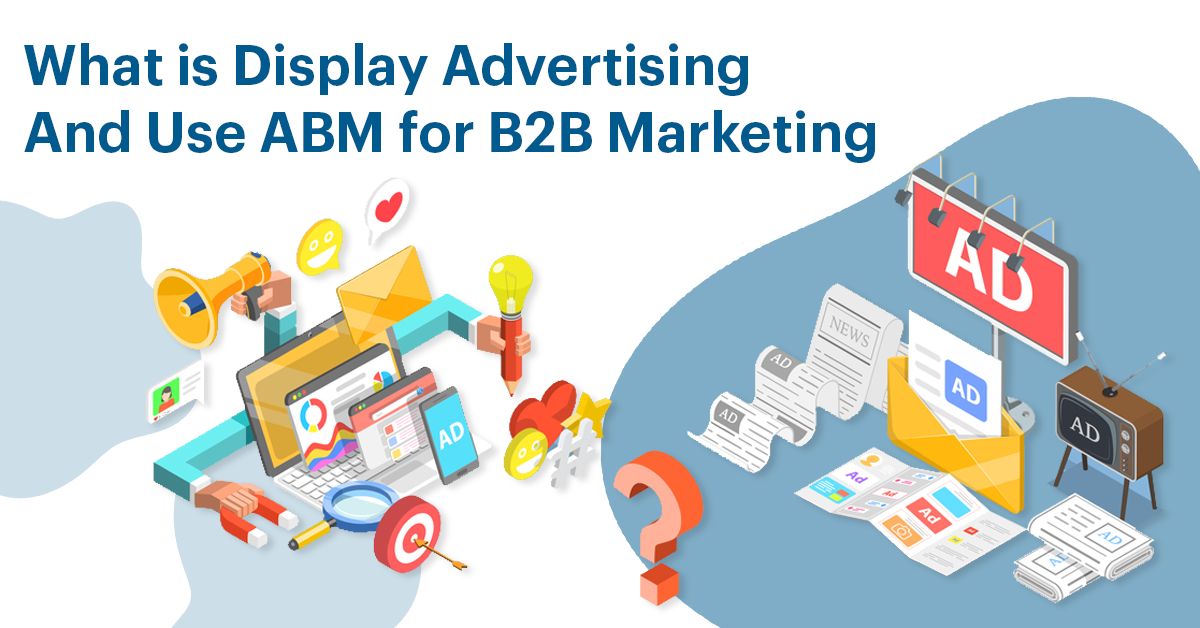Display advertising stands as one of the most powerful tools in B2B marketing because it boosts a company’s image, attracts new customers, and drives conversions. This article will discuss the role of display advertising in an Account-Based Marketing environment.
When engaging with display ad campaigns within an ABM strategy, B2B firms can effectively concentrate on targeted accounts and specific messages to maximize achievement.
What is Display Advertising?
Display advertising is integral to contemporary B2B marketing strategies that help companies increase their brand’s visibility, entice potential clients, and increase conversions.
In this post, we’ll explore the idea of display advertising and the ways it can be employed for account-based marketing (ABM) strategies.
Display ads show products based on user behavior, demographics, or interests—unlike descriptive ads that rely on user-initiated search.

Understanding Display Advertising
Display advertising uses eye-catching banners, images, or videos to promote products or services across websites and digital marketing platforms.
Unlike search ads, display ads reach users based on their interests, browsing activity, and demographics—helping brands stay top-of-mind.
Demand base, one of our advertising platforms, is an account based advertising platform targeting B2B companies and users from the appropriate accounts. The Demandable display adS campaigns appear on publisher websites, the social media and mobile apps.
The Role of Advertising in ABM
Display advertising is crucial in account-based marketing (ABM), enabling companies to engage and connect with key accounts more effectively.
Customized Personalization
ABM display ads offer enhanced personalization, letting businesses customize experiences for specific target accounts. With account-level insights, businesses personalize ads to address each customer’s unique challenges, needs, or goals throughout their buying journey.
Account-Based Targeting
B2B display ad platforms offer precise targeting, enabling companies to focus campaigns on the most relevant and high-value business accounts. Targeting fewer, high-potential accounts helps brands improve ad impact and drive higher engagement with decision-makers that truly matter.
Multi-Channel Engagement
Display ads can be part of an ABM strategy, engaging target accounts across digital spaces—social media, websites, and streaming platforms. The multi-channel strategy allows firms to target their clients across multiple channels and boost branding visibility.
Display ads combined with ABM allow businesses to reach decision-makers in target accounts, strengthening relationships and boosting conversion opportunities.
Creating Effective ABM Display Advertising Campaigns
To run successful ABM display ad campaigns, businesses should follow a clear and structured approach tailored to target accounts.
1. Setting out Campaign Goals and Targets
When launching an advertising display campaign, it’s essential to establish specific goals and targets. Align your display advertising strategy with ABM objectives, like brand awareness and lead generation, by setting SMART, measurable campaign goals.
2. Finding Target Accounts and the Personas of Those Accounts
Identifying key individuals and target accounts is a vital part of ABM. Data helps businesses focus on ideal customers by aligning sales and marketing teams to target high-value accounts more effectively.
Identifying key decision-makers and influencers—also called buying committees—is essential for crafting personalized and relevant display ad messages.
3. Designing Creative and Compelling Ads
Ad creatives comprise visual and textual components that draw the attention of the intended public. Ensure ABM ad creatives align with tailored messaging and value proposition specific to each target account for effective promotion.
A compelling visual, persuasive copywriting, and a clearly defined Call-to-Action (CTA) are the most important components of an effective creative.
If you follow these tips, B2B businesses can create advertisements based on accounts that reach their targeted accounts and achieve the results they want.
Best Practices for Display Advertising in ABM
To ensure the effectiveness of advertising displays in the context of the framework of an ABM strategy, you must follow the most effective guidelines.
Improving the Way You Communicate With your Account’s Demands
To connect with your audience, align your display ad messages with their unique needs and challenges. Understanding the issues and offering solutions that are tailored to the specific context of each client improves the likelihood of the engagement of users and conversion.
Testing A/B and Continuously Optimizing
A/B testing is the process of experimenting with various variations of creatives for ads as well as messaging or other parameters to determine the most effective combinations. Through constant testing and optimization of advertisements for display, companies will improve efficiency and enhance outcomes.
Monitoring Campaign Performance
Monitoring and tracking the effectiveness of display ads is vital to determine the effectiveness of these campaigns. Analyzing account-based metrics such as clicks, impressions, CTR, and conversions helps organizations optimize campaigns and make informed marketing decisions.
Retargeting Strategies And Nurturing
Display ads support retargeting by showing personalized advertisements to users who previously visited your website or showed interest in your products. Using retargeting and nurturing strategies with display ads keeps your brand memorable and increases the likelihood of customer conversions. By following these guidelines, businesses optimize their ABM marketing strategies and campaign performance to maximize impact, efficiency, and overall ROI.




